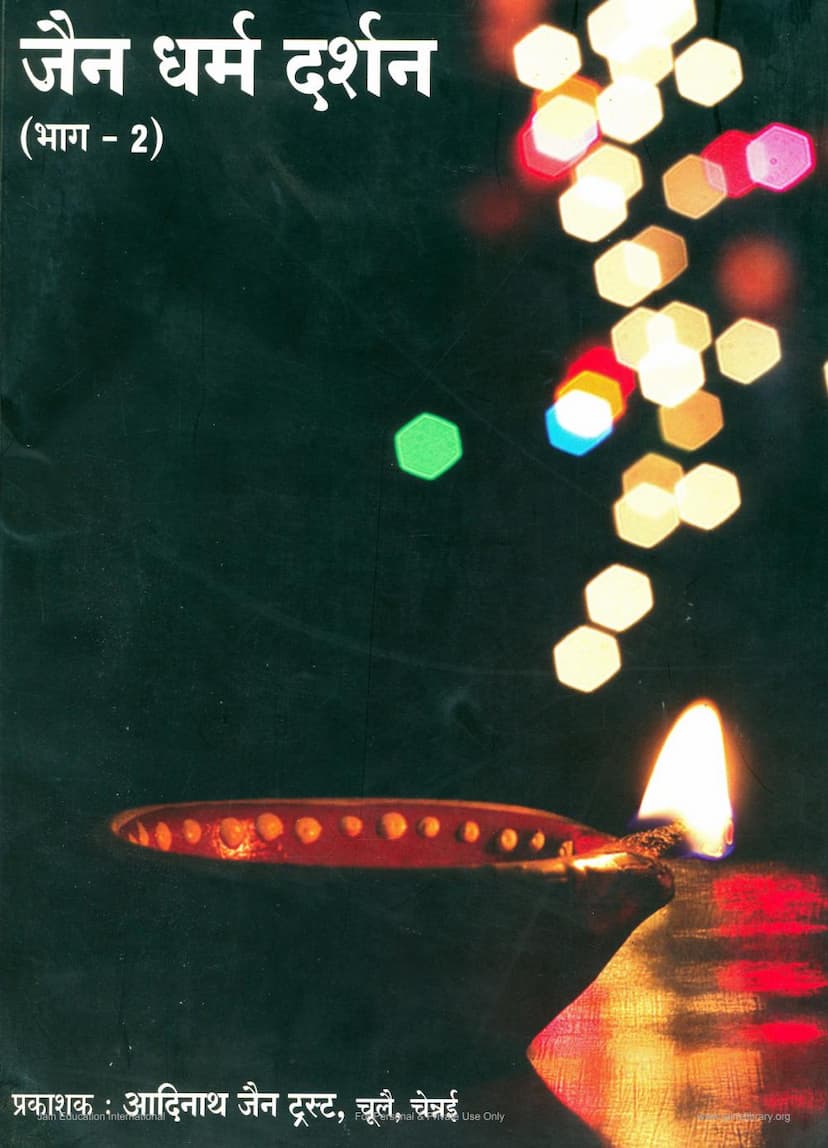Jain Dharm Darshan Part 02
Added to library: September 1, 2025
Loading image...

Summary
This document is the second part of "Jain Dharm Darshan" (Jain Philosophy) by Nirmala Jain, published by Adinath Jain Trust. It's part of a curriculum designed by Jain Education International.
The book is structured into several sections, covering:
1. Jain History:
- Biographies of Tirthankaras: Detailed life stories of Lord Parshvanath (23rd Tirthankara), Lord Shantinath (16th Tirthankara), and Lord Arishtanemi (22nd Tirthankara). These sections trace their past lives, significant events like their conception, birth, renunciation, enlightenment, and liberation, highlighting the principles of Jainism through their lives.
2. Jain Philosophy (Tatva Mimansa):
- Ajeeva Tatva (Non-soul substances): Explains the fundamental non-living categories in Jainism:
- Dharmastikaya: The medium of motion.
- Adharmastikaya: The medium of rest.
- Akashastikaya: Space, which encompasses both the realm of the universe (Lokakasha) and the non-universal realm (Alokakasha).
- Kal: Time, discussing its nature and its division into Nischaykal (intrinsic time) and Vyavaharkal (conventional time).
- Pudgalastikaya: Matter, explaining its characteristics like form, touch, taste, smell, and its various modifications.
- Punya Tatva (Merit/Virtue): Discusses the concept of merit and its nine types (giving food, water, shelter, bedding, clothes, good thoughts, good speech, good actions, and respect). It distinguishes between Punyanubandhi Punya (merit that leads to further merit) and Papanubandhi Punya (merit that leads to sin). It also elaborates on the purpose and gradual renunciation of Punya.
- Papa Tatva (Sin/Demerit): Explains sin as the opposite of merit, detailing its two types (Dravya Papa and Bhava Papa) and its classifications like Papanubandhi Papa and Punyanubandhi Papa. It extensively lists and explains the 18 types of sins (Pap Sthan), including violence, falsehood, theft, lust, greed, anger, pride, deceit, envy, attachment, hatred, quarreling, slander, backbiting, and incorrect views.
- Ashrava Tatva (Influx of Karma): Defines Ashrava as the entry point of karmas into the soul, caused by the interaction of the soul's activities (Yoga) with the senses, passions, vows, and actions. It details the 42 types of Ashrava, categorized into Indriya (senses), Kashaya (passions), Avrat (lack of vows), Kriya (actions), and Yoga (activities of mind, speech, and body). It highlights the role of inner disposition (Adhyavasaya) over external actions in determining the nature of karma influx.
3. Jain Ethics (Achar Mimansa):
- Marganusari Jeevan (Life in Accordance with the Path): This section outlines the principles of a life that follows the Jain path to liberation. It categorizes 35 virtues, divided into:
- 11 duties for household life (e.g., earning justly, spending within means, appropriate conduct, marriage, cleanliness, mindful eating, respecting parents, supporting dependents, hospitality, serving the learned).
- Abstinence from 8 vices (e.g., backbiting, forbidden actions, indulgence, attachment to senses, uncontrolled passions, pride, bad company, impure conduct).
- Adherence to 8 virtues (e.g., being pious, modest, gentle, popular, far-sighted, knowledgeable about strengths and weaknesses, expert, and favoring virtue).
- 8 practices of spiritual discipline (e.g., gratitude, benevolence, compassion, associating with the virtuous, listening to religious discourse, and cultivating eight qualities of intellect).
4. Jain Karma Mimansa (Theory of Karma):
- Jnanaavarniya Karma: Karma that obstructs the soul's knowledge. It explains the five types (Mati-Jnanaavarniya, Shruta-Jnanaavarniya, Avadhi-Jnanaavarniya, Manahparyav-Jnanaavarniya, Keval-Jnanaavarniya) and the causes for its bondage (e.g., disrespect for knowledge, malice, obstruction, deception, quarreling). It also suggests remedies for overcoming this karma.
- Darshanavarniya Karma: Karma that obstructs the soul's perception or general awareness. It describes its nine types (e.g., causing different degrees of sleep, stupor, and dullness) and the causes for its bondage (e.g., criticizing the virtuous, advocating false beliefs, disrespecting the wise, and envy). It also offers remedies.
- Vedaniya Karma: Karma that causes experiences of pleasure and pain. It's divided into Sata-Vedaniya (pleasant experiences) and Asata-Vedaniya (unpleasant experiences). The text details the causes for bondage of both types, such as devotion to gurus, forgiveness, compassion, adherence to vows, auspicious mental states, control of passions, charity, and steadfastness in faith for Sata-Vedaniya, and disrespect, anger, cruelty, lack of vows, inauspicious actions, passions, stinginess, and lack of faith for Asata-Vedaniya. It also lists the results of experiencing these karmas.
5. Sutras related to Religious Practices:
- The book provides the text and explanations of important Jain mantras and prayers, including:
- Iriyavahiyam (Pratikraman) Sutra: A prayer for atonement for accidental harm caused to living beings while walking.
- Tassa Uttari Sutra: A prayer for further purification and renunciation of sins.
- Annath Sutra: A prayer for protection from bodily disturbances during meditation.
- Logassa Sutra: A hymn of praise for all 24 Tirthankaras.
- Karemi Bhante (Samayik) Sutra: A prayer for undertaking the practice of Samayik (equanimity and mindfulness).
- Bhagavan! Dashanm Bhaddo Sutra: Prayers associated with the completion of Samayik and Paushadh (fasting).
- Samaiy Vay Jutto Sutra: A prayer for Samayik observance and its benefits.
- Eyss Navamass Sutra: Explains the virtues of observing Samayik and the consequence of doing so.
6. Life Stories of Great Souls:
- Dhandhan Muni: The story of a disciple of Lord Arishtanemi who, through intense penance and overcoming great obstacles, attained liberation.
- Sadhvi Pushpachula: The life story of a female ascetic whose past actions and resolutions led to her unique destiny.
- Samrat Samprati: The life of Emperor Samprati, a devout Jain ruler who spread Jainism and built numerous temples.
- Mahasati Draupadi: The life story of Draupadi, detailing her past lives, the karmic reasons behind her unique marital situation, and her spiritual journey towards liberation.
The book emphasizes the importance of understanding Jain philosophy, history, and practices for spiritual development and liberation. It also includes information about a correspondence course offered by Adinath Jain Trust.